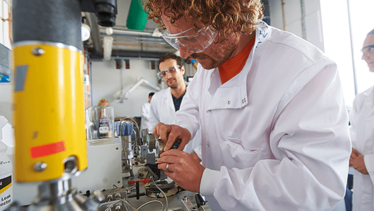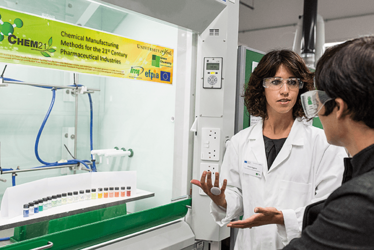Chemical Alliances
A multimillion Euro project is pushing green chemistry forward in Europe. The secret of its success? Collaboration, collaboration, collaboration! CHEM21 is a €26 ($29) million project that brings together European pharmaceutical companies, universities and small to medium enterprises to develop more sustainable pharmaceutical manufacturing.

Photo credit: John Houlihan, The University of York
The project launched in 2012, after successfully bidding for funding from Europe’s Innovative Medicines Initiative. The companies involved – members of the European Federation of Pharmaceutical Industries and Associations (EFPIA) – had for several years felt that there were gaps in their manufacturing technology portfolio. Promising technology to improve sustainability was being explored in academic labs, but was not yet available for large-scale use. Some members are also looking to utilize any new chemistry developed in drug discovery programs.
CHEM21 accelerates the development of sustainable technology with five working groups:
- Horizon scanning: examines where we are now and where we might be 5 or 10 years in the future, to ensure that the technology being developed is relevant now and in the future.
- Chemo- catalysis and flow processing: develops more sustainable chemical catalysts and processes.
- Biocatalysts: identifies and refines novel biocatalysts to replace inefficient chemical catalysts.
- Synthetic biology: uses microorganisms to transform simple carbon sources into high-value chemical intermediates.
- Training and education: creates a world-class, interactive training package, which will open to the entire industry at the end of the project.
Project coordinator Nicholas Turner, a professor at the University of Manchester, is quick to point out that none of these elements works in isolation. “One thing that sets CHEM21 apart is the seamless integration of chemical and biological approaches to sustainable manufacturing.”
CHEM21 involves 21 different organizations. And while there is strength in numbers, working in such a large consortium can be challenging. “We are working on sensitive new chemical entities and drugs in development so there are sensitivities between the companies about exactly what we want to reveal to each other,” says project coordinator Murray Brown of GlaxoSmithKline. “It has also been important to remember that the academics are here to provide cutting edge research, not to be treated as contract research organizations, so they need to have trust that they aren’t being exploited for commercial gain.” To alleviate any confidentiality concerns, the drugs for research projects are carefully chosen, with a focus on World Health Organization-defined Essential Medicines. “They are often part of a company’s philanthropic portfolio, rather than their ‘crown jewels’”, says Brown. “Increasingly now we see people being prepared to share things that they might originally have been a bit nervous about. We are now very much a unified consortium, and I think that is a great achievement.”
The project has just passed the halfway mark of its four-year funding period, and much has been achieved already. “We’ve now got a large portfolio of promising new technology, new catalysts, and new reactions that have come out of the academic partners. Companies are now looking at how they can use those technologies and some are already being scaled up. So we’ve gone from academic labs to industry labs and heading towards small-scale pilot plants in just two years,” says Andy Wells, Charnwood Technical Consulting.

Photo credit: Ian Martindale, The University of York
Brown highlights the work on synthetic biology as one of the success stories of the project. Companies have long wanted to use genetic engineering to create microorganisms capable of producing valuable chemicals as a means for more efficient, sustainable manufacturing. What has been missing is a toolbox – a collection of techniques and technologies that companies can use ‘off the shelf’ to explore this potential (see January’s “Rebirth of Manufacturing”). CHEM21 academic partners have also addressed that missing link. “The toolbox has done a lot towards clarifying the complex IP landscape of synthetic biology and making it much easier for us to operate freely,” says Brown. “Now the challenge is to convert that toolbox into real industrial processes.”
Technology transfer is often a stumbling block in academic–industry collaborations, and CHEM21 is designed to make the process as easy as possible. Turner says that PhD students and post docs worked in close collaboration with industry staff from day one. “The best way to transfer technology is to transfer people, so we sent students off to work in industry for anything from a week to 2–3 months. We have also taken company staff into the academic labs for training. It’s all part of the exchange of information, technology and expertise.” GlaxoSmithKline have already felt the benefit of this close collaboration, adds Brown. “The consortium gives us the opportunity to work together to improve the process, whereas if we were just buying in technology from a third party supplier it would be much harder to have that level of interaction.”
Wells agrees, “I hope that this will become the model for how industry should collaborate with academia.”
As the project moves into the final two years, the focus will be increasingly on translating new technologies into economically viable processes, says Wells. “It’s very exciting to see the result of the research and the speed at which we are getting ground-breaking new science being picked up and used in real-life industrial examples.”
Find out more about the CHEM21 project at www.chem21.eu
Translation Taster
Just a sample of the wide range of practical advances being developed as part of CHEM21.
- C-H activation chemistry developed at Antwerp University is being applied to find a greener manufacturing route to GSK’s anthelminthic drug albendazole.
- Enzymatic routes are being identified to produce ethambutol, a key component of TB therapy.
- A reaction database has been set up that allows researchers to assess how green a biocatalytic reaction is.
- Direct fluorination, using elemental fluorine as the fluorinating agent, is being explored as a replacement for current approaches.
- Research at the University of York is developing silica catalysts as cleaner alternatives to wasteful reagents used for amide bond formation.



















